
Prop Walk: Understanding the Phenomenon and How to Navigate It
by Emma Sullivan | Jul 22, 2023 | Sailboat Racing

Short answer (prop walk): Prop walk is the tendency of a boat to deviate sideways from its intended course when in reverse. This phenomenon is caused by the deflection of water flow created by the rotation of the propeller. It can have significant effects on maneuverability and requires skillful handling by boaters.
Understanding Prop Walk: A Comprehensive Guide
Have you ever wondered why your boat behaves differently when maneuvering in reverse compared to forward? Or why it seems to stubbornly veer off to one side when trying to go straight? The answer lies in a phenomenon known as prop walk. In this comprehensive guide, we will delve into the fascinating world of prop walk, unraveling its mysteries and shedding light on its effects on boat handling.
So what exactly is prop walk? Simply put, it is the sideways force generated by a spinning propeller when a vessel is in reverse. This force tends to push the stern of the boat towards one side, causing it to pivot around that point. Understanding this concept is crucial for any boater looking to master their vessel’s maneuverability.
Prop walk can be influenced by various factors such as hull design, weight distribution, propeller size and pitch, and even water current. It manifests differently depending on the direction of rotation of the propeller blades. For example, a right-handed or clockwise rotating propeller will create more prop walk when in reverse compared to a left-handed or counterclockwise rotating one.
Now let’s tackle how prop walk affects boat handling. When maneuvering in reverse, the sideways force exerted by the prop walk can cause your vessel’s stern to swing either to port (left) or starboard (right), depending on various factors mentioned earlier. This sideward movement may seem unpredictable at first but can be harnessed with practice and understanding.
Knowing how your specific boat reacts to prop walk is essential for precise docking and navigating tight spaces. With experience, you’ll be able to anticipate and compensate for these lateral forces, becoming a skilled captain who effortlessly glides through marinas like a seasoned pro.
To counteract prop walk when going astern, there are several techniques at your disposal. One common method involves using short bursts of throttle accompanied by timely adjustments of the helm (steering), effectively counterbalancing the sideways force. Another approach is to utilize spring lines or dock lines to help pivot your boat in the desired direction, minimizing the effects of prop walk.
While prop walk is most evident when maneuvering in reverse, it can also have subtle effects on a vessel’s behavior when going forward. These effects are often felt as an unwanted veering off course or difficulty maintaining a straight line. Understanding that prop walk may persist even in forward motion can aid in better navigation and course correction while underway.
In conclusion, understanding prop walk is essential for any boater seeking mastery over their vessel’s maneuverability. By recognizing its causes, effects, and how to counteract it, you’ll be well-equipped to navigate tight spaces with confidence and finesse. So don’t let prop walk catch you off guard – arm yourself with knowledge and become the captain who effortlessly tames the forces of nature.
Mastering Prop Walk: Step-by-Step Instructions for Smooth Maneuvering
Are you a boating enthusiast who has experienced the challenge of maneuvering your vessel in tight spaces? If so, you’re probably familiar with prop walk – that mysterious and sometimes frustrating phenomenon where your boat seems to have a mind of its own. Fortunately, prop walk can be tamed through careful understanding and practiced technique. In this blog post, we will take you through step-by-step instructions to help you master prop walk and achieve smooth maneuvering in any situation.
Before we dive into the technical details, let’s briefly explain what prop walk actually is. Prop walk occurs due to the rotation of your boat’s propeller beneath the water. Depending on whether your propeller rotates clockwise or counterclockwise (determined by its design), it produces a corresponding propulsion force that affects how your vessel behaves when shifting gears or turning.
Now, let’s get started with our step-by-step instructions:
1. Know Your Boat: Before attempting any precise maneuvers, it’s crucial to understand your boat’s specific characteristics. Take some time to study your boat’s owner manual and become acquainted with its propulsion system and engine configuration. This knowledge will serve as a solid foundation for mastering prop walk effectively.
2. Practice Docking in Calm Conditions: To gain confidence in maneuvering your vessel smoothly, start by practicing docking in calm conditions. Choose a quiet location away from other boats or obstacles where you can focus solely on honing your skills at controlling prop walk without distractions or added pressure.
3. Utilize Slow-Speed Operation: When dealing with tight spots and limited space, slow-speed operation is key to maintaining control over prop walk. Ensure that you are well-versed in operating at low RPMs (revolutions per minute) so that you can minimize the propulsion forces generated by your engine, reducing the influence of prop walk.
4. Understand Your Propeller Rotation: As mentioned earlier, prop walk is influenced by the rotation direction of your boat’s propeller. By understanding which way your propeller turns (clockwise or counterclockwise), you can anticipate and counteract the corresponding forces that will be at play during maneuvers. This knowledge will enable you to make precise adjustments and minimize the impact of prop walk.
5. Master Throttle Control: The key to controlling prop walk lies in mastering throttle control. Practice controlling the power input through precise manipulation of throttle settings. Gradually increase or decrease throttle as needed to mitigate the effects of prop walk during critical moments, such as when approaching a dock or making tight turns.
6. Use Rudder Techniques: In combination with throttle control, proper utilization of your rudder can significantly enhance maneuverability and counteract prop walk. Learn how different rudder positions affect your vessel’s behavior and experiment with slight adjustments to achieve desired outcomes.
7. Predictable Weight Distribution: Distributing weight evenly throughout your boat contributes to predictable handling and reduces surprises caused by imbalanced loads affecting prop walk characteristics. Keep an eye on where passengers are positioned while maneuvering, especially during critical moments.
8. Leverage Wind and Currents: Rather than fighting against nature, try using wind and currents to your advantage whenever possible. Understanding their influence on your boat’s movement will help you set up more efficient approaches when dealing with tight spaces or challenging docking scenarios.
9. Practice Makes Perfect: Lastly, remember that mastering any skill takes practice! The more time you dedicate to understanding and experimenting with prop walk techniques outlined above, the better you will become at predicting its behaviors and ultimately achieving smooth maneuvering in various conditions.
So there you have it – step-by-step instructions for mastering prop walk! By following these guidelines, being patient with yourself, and embracing a bit of trial-and-error learning process, you’ll soon find yourself confidently gliding through even the trickiest of maneuvers. Happy boating!
Prop Walk FAQ: Answers to Common Questions About Handling Propeller Effect
Are you a boat owner or enthusiast who has heard the term “prop walk” but is unsure about its meaning and how it affects your vessel’s maneuverability? Don’t worry; you’re not alone! In this blog post, we’ll explore some frequently asked questions about prop walk and provide detailed, professional, witty, and clever explanations to help you better understand this phenomenon.
1. What exactly is prop walk? Prop walk refers to the sideways movement or rotation of a boat when maneuvering at low speeds due to the interaction between the propeller’s rotation and water flow. This effect is caused by a combination of factors such as the propeller’s design, its position on the boat’s hull, and the engine’s power output.
2. How does prop walk affect my boat’s handling? Prop walk can significantly impact your boat’s maneuverability, especially during tight turns or docking. For example, if you’re trying to turn your boat to port (left), prop walk might cause it to move slightly towards starboard (right) before making a left turn due to water pushing against the rudder or hull. Understanding prop walk will allow you to anticipate these movements and adjust your steering accordingly.
3. Can I minimize or eliminate prop walk altogether? While it may not be possible to eliminate prop walk completely because of its natural occurrence, there are a few techniques that can help mitigate its effects:
– Use opposite thrust: Applying counteracting thrust by briefly shifting into reverse gear can help counterbalance the prop walk effect and bring your boat back on track. – Adjust trim tabs: Experimenting with trim tab positions can sometimes offset uneven forces caused by propellers. – Practice deliberate maneuvers: Over time and with practice, understanding how your particular vessel responds during different situations involving low-speed turns will enable you to predict and compensate for any unwanted propulsion effects.
4. Is prop walk more pronounced in certain boats or engines? The extent of prop walk can vary depending on multiple factors, including the design and configuration of your boat’s hull, the size and position of your propeller(s), as well as the power output and torque characteristics of your engine(s). In general, single-engine boats will experience more noticeable prop walk compared to twin-engine vessels.
5. Are there any advantages to prop walk? Believe it or not, although sometimes considered a nuisance, prop walk does offer some benefits. Skilled boaters can actually harness this effect to their advantage in close quarters maneuvering by using it as an additional steering tool. Utilizing prop walk strategically enables captains to navigate tight spaces with greater precision and control.
6. Should I be concerned if my boat exhibits excessive prop walk? While some degree of prop walk is normal and expected during low-speed maneuvering, excessively strong or unpredictable effects should be investigated further. Potential causes could include improper installation, damaged components, or issues with alignment between the engine and drive system. If you’re experiencing unusual levels of prop walk, it’s advisable to consult a marine mechanic for a thorough inspection.
Understanding the intricacies of prop walk will undoubtedly enhance your ability to handle your vessel effectively at low speeds. By familiarizing yourself with its behavior and incorporating appropriate techniques into your boating skills repertoire, you’ll gain confidence in navigating tight spots while impressing fellow boaters with your newfound knowledge.
In conclusion, whether you’re an experienced sailor looking to brush up on nautical knowledge or a novice eager to learn more about boat handling peculiarities like prop walk — understanding how this phenomenon affects your vessel’s behavior will undoubtedly transform you into a skilled captain capable of effortlessly maneuvering through any situation that arises on the water!
Unraveling the Mystery of Prop Walk: How It Works and Why It Matters
Have you ever wondered why your boat seems to have a mind of its own when maneuvering in tight spaces? Well, fear not, fellow boaters, for we are about to uncover the enigmatic phenomenon known as “prop walk.” Let’s lift the veil on this mystery and dive into the depths of understanding how it works and why it matters.
At first glance, prop walk might appear like an unfathomable force that only experienced mariners can comprehend. However, beneath its seemingly perplexing nature lies a logical explanation rooted in fluid dynamics. So let’s embark on this intriguing journey together!
Prop walk is essentially the sideways force generated by a rotating propeller in operation. When your boat is put into reverse or forward gear, water is expelled astern (behind) or ahead (in front) of the vessel respectively. This expulsion creates a reactive force that pushes against the rudder or hull – resulting in either desired or unintended lateral movement.
Now that we’ve demystified what prop walk actually is, let’s explore the mechanics behind its operation. The direction of prop walk can typically be predicted based on three primary factors: rotation direction, blade pitch (angle), and hull design.
Firstly, the rotation direction plays a vital role in determining whether your boat will experience port-side (left) or starboard-side (right) prop walk. For example, if your propeller rotates counterclockwise as viewed from aft – which is most common for right-handed props – expect port-side prop walk.
Secondly, blade pitch influences the severity of prop walk. Higher blade pitches generate more thrust but also exacerbate sideways forces caused by water displacement. Hence, boats with higher-pitched blades typically experience more pronounced prop walk compared to those with lower pitches.
Finally, your vessel’s hull design significantly affects how prop walk manifests itself. Boats with fuller, rounder hull shapes, such as displacement hulls, have greater prop walk tendencies due to increased water resistance and displacement effects. In contrast, boats with flatter or planing hulls exhibit reduced prop walk characteristics.
Now that we’ve delved into the intricacies of prop walk’s mechanics, you might be wondering why it matters in your everyday boating adventures. Well, understanding prop walk and its effects is crucial for maneuvering your vessel safely and confidently.
While prop walk may seem like an unpredictable force at first glance, mastering its influence can enhance your docking and low-speed handling abilities. By anticipating the direction and magnitude of prop walk specific to your boat’s setup, you can make precise adjustments to compensate for its sideways movement.
Moreover, being aware of how prop walk affects your boat enables you to plan ahead while navigating in tight quarters – preventing potential collisions or accidents. It empowers you to strategize more effectively when approaching docks or entering crowded marinas with limited space for error.
In conclusion, unraveling the mystery of prop walk sheds light on a fundamental aspect of boating physics that often bewilders enthusiasts worldwide. By comprehending how it works and why it matters during maneuvers, you equip yourself with the knowledge needed to navigate confidently through any challenging docking scenario.
So next time you find yourself marveling at the wonders of prop walk aboard your vessel, remember that behind this mystifying phenomenon lies a captivating amalgamation of rotation direction, blade pitch, and hull design – all conspiring together to determine your boat’s lateral movement. Now go forth and conquer those tight spaces like a true captain!
Navigating with Confidence: Conquering Prop Walk Challenges on Your Boat
Introduction: When it comes to navigating a boat, having confidence in your skills is key. However, one challenge that many boaters face is dealing with prop walk – the phenomenon where the boat’s stern swings to one side when in reverse. But fear not! In this blog post, we will delve into this common issue and provide you with professional, witty, and clever strategies to conquer prop walk challenges on your boat.
Understanding Prop Walk: Prop walk occurs due to the rotation of the propeller and its interaction with water. As most boat propellers rotate clockwise when viewed from behind the vessel, they create a lateral force that pushes the stern towards the portside (left) when in reverse. This force can make maneuvering tricky, especially for inexperienced boaters.
Mastering Techniques to Overcome Prop Walk:
1. The Pivot Point Technique: To counter prop walk’s pull towards one side, understanding your vessel’s pivot point is crucial. Imagine a point near the bow where your boat spins around. By utilizing this knowledge effectively during reverse maneuvering, you can adjust your approach and minimize or neutralize prop walk’s effect.
Professional tip: Finding your pivot point requires practice and observation but once mastered; you’ll be able to use it as an advantage over others who may be struggling with their boats’ maneuverability.
2. Throttle Control: Gaining control over throttle manipulation is another crucial element in conquering prop walk challenges on any boat. By skillfully controlling forward and reverse thrusts using slight adjustments on your throttle lever or joystick (if equipped), you can exert more control over how the boat reacts to prop walk forces.
Witty advice: Think of adjusting throttle like playing a musical instrument – finesse is key! A gentle touch here and there can help you navigate through tricky maneuvers smoothly without letting prop walk take control of your steering.
3. Rudder Usage: The rudder is your trusted ally when combating prop walk. By strategically using the rudder in combination with throttle control, you can actively counteract the stern swing and keep your boat on a desired path. Turning the wheel or joystick steadily towards the same direction as prop walk helps overcome its effects.
Clever maneuvering hack: Picture yourself gracefully dancing on a ballroom floor – just like leading your partner during a waltz, using your rudder correctly will allow you to glide smoothly through any reverse maneuver, defying prop walk’s attempt to throw you off balance.
4. Practice Makes Perfect: As with any new skill, practice is crucial for conquering prop walk challenges efficiently. By dedicating time to hone your maneuvering techniques in various scenarios (such as docking or close-quarters situations), you can build confidence and develop an intuitive understanding of how your specific boat responds to prop walk forces.
Professional suggestion: Consider enrolling in boating courses or hiring an experienced instructor who can provide hands-on guidance tailored to your vessel type, reducing learning curves while boosting efficiency.
Conclusion: Remember that navigating with confidence involves conquering every challenge that comes your way – including prop walk on your boat. With these professional, witty, and clever strategies at hand, you’ll be better equipped to understand and manage the forces at play during reverse maneuvers. So don’t let prop walk get the best of you – take control like a seasoned captain and sail away with confidence!
Demystifying Prop Walk: Essential Tips and Techniques for Seamlessly Handling Your Vessel
Are you a boating enthusiast who has experienced the curious phenomenon known as prop walk? If so, you’re not alone! Many sailors and powerboaters have struggled to navigate their vessels smoothly due to this mysterious phenomenon. But fear no more, as we are here to demystify prop walk and provide you with essential tips and techniques that will help you handle your vessel seamlessly.
So, what exactly is prop walk? Well, it refers to the sideways movement or rotation of a boat caused by the propulsion force generated by its propeller. The main culprit behind this peculiar behavior is asymmetrical thrust, which arises when the blades of the propeller interact with water unevenly. This imbalance creates an unequal distribution of forces that can cause your vessel to veer off course or rotate unexpectedly.
Now that we have established what prop walk is, let’s delve into some valuable tips and techniques that will transform you into a master navigator:
1. Understand Your Boat’s Propeller Configuration: It’s crucial to have a clear understanding of your boat’s specific propeller configuration. Different types of boats (sailboats vs. powerboats) may have single or multiple propellers with varying pitch angles and blade designs. Knowing these details will give you insight into how your vessel reacts to different throttle inputs.
2. Master Throttle Control: Skillful management of throttle control is key to mitigating the effects of prop walk effectively. Gradual adjustments rather than sudden changes in throttle settings can help minimize unwanted oscillation or rotation caused by asymmetric thrust.
3. Utilize Rudder Steering: One effective technique for counteracting prop walk is using rudder steering in conjunction with throttle manipulation. By applying slight opposite rudder amidst acceleration or deceleration, you can significantly reduce the sideways movement induced by prop walk.
4. Be Mindful of Prop Walk While Docking: Docking can be a nerve-wracking experience for even the most seasoned boat handlers. Understanding how prop walk affects your vessel during slow-speed maneuvers is crucial. Practice precise throttle control and employ rudder steering to your advantage, carefully compensating for the sideway movement generated by your propeller.
5. Experiment with Propeller Walk: Keep in mind that prop walk may not always have negative implications. In certain situations, such as tight turns or confined spaces, the same phenomenon can be harnessed to your advantage. By understanding how to utilize controlled prop walk, you can execute sharp turns with precision and finesse.
Remember, mastering prop walk takes time and practice. Every boat is unique, and it’s essential to familiarize yourself with its characteristics through trial and error. By incorporating these tips into your boating repertoire and staying patient with yourself, you’ll gradually become more adept at navigating smoothly despite the occasional quirks of prop walk.
In conclusion, don’t let prop walk mystify or intimidate you any longer! Armed with these essential tips and techniques, you now possess the knowledge required to handle your vessel seamlessly. So go out there, put these strategies into action, and enjoy a newfound confidence as you conquer the waterways like a true professional sailor or powerboater!
Recent Posts

- Sailboat Gear and Equipment
- Sailboat Lifestyle
- Sailboat Maintenance
- Sailboat Racing
- Sailboat Tips and Tricks
- Sailboat Types
- Sailing Adventures
- Sailing Destinations
- Sailing Safety
- Sailing Techniques
- Members Forum
- Log In / Create Account
Understanding and Using Prop Walk
by Harbor Sailboats | Dec 4, 2020 | Blog | 0 comments

Submit a Comment Cancel reply
You must be logged in to post a comment.
Latest Blog Posts
- Talk and Walk
- Sailing Lessons in San Diego
- Water in the Bilge
- Bow Standing
- Gear then Steer
- Propeller Basics 5
- Propeller Sizing 3
- Tip Clearance 3
- Engine and Gearbox 3
- Cathodic Protection 5
- Vibration 6
- Antifouling 3
What is Prop Walk?
Prop walk occurs when a turning propeller pushes a boat’s stern sideways. A single right-handed fixed propeller will tend to push the stern of a vessel to starboard when going forward and to port when going in reverse.
Prop walk affects most single-engine vessels. Also known as “ asymmetric blade thrust,” prop walk is due to the downward propeller shaft angle being not parallel to the water’s surface (most sailboats’ shaft angle is between 8 and 14 degrees) creating difference in the cylindrical distance traveled by the propeller blades on their upstroke versus the downstroke. The water at the bottom of the propeller is a bit denser and freer to flow (there is no hull above it) than at the top of the propeller. The upstroke of the lower blades is a bit more effective pushing more water, generating more thrust on that side. The lateral deflection off the hull, pushes the boat’s stern sideways, pivoting the vessel around a point located about one-third of the boat’s length aft from the bow. The propeller and the stern “walk” sideways in the direction of rotation.
A single right-handed fixed propeller will tend to push the stern of a vessel to starboard when going forward and to port when going in reverse.
There are a number of factors that contribute to prop walk in reverse. In reverse the boat acts like pushing a grocery trolley backwards, it is more critical to steer as any very small movement of the wheels gives a big course change – the same in reverse as to where the rudder is located in respect to the boat and keel.


What is Propwalk on a Sailboat?
The information contained in this explanation of what is propeller-walk (aka “propwalk”) comes directly from the NauticEd Maneuvering and Docking a Sailboat Under Power sailing course which forms part of the requirement for the NauticEd Sailing Certification ranks of Skipper, Bareboat Charter Master, and Offshore Captain.
You’ve learned to sail, sailed for a few years, and now you’ve upgraded to a bigger boat with an inboard engine. How frustrating! You want your new sailboat to go backward but you keep going sideways. Welcome to propwalk. GRRRRR. This is not something that you probably got taught at your local sailing school because you learned on a smaller boat with maybe an outboard. Now you’ve got a much bigger and heavier boat and there are more expensive mistakes that can be made. Propwalk can be frustrating or you can understand it and use it to your advantage.
What is Propwalk?
Propwalk is when two phenomena working together.
1. The First Phenomenon is the “P” factor.
In single-engine propeller-driven airplanes, just as the pilot pulls back on the stick on takeoff after the plane has attained flying speed, the plane tends to yaw sideways and the pilot must counter with the tail fin rudder. The same yaw effect happens in a sailboat.
To explain, imagine you’re walking up a spiral staircase. Each step is the same height and requires the same amount of energy to go up the next step.

Spiral staircase
Now imagine if the spiral staircase was tilted over 20 degrees. You’d find that as you went around the stairs they would be steeper on one side and flatter on the other. Or the stepper side cuts through more vertical space than the flatter side.
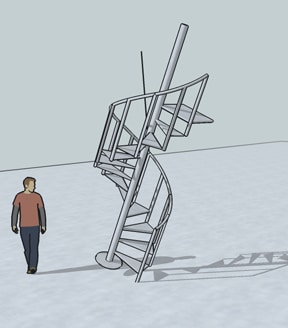
Staircase tilted
As we look at a propeller and the water flowing through it, the arc that the tips of the propeller follow relative to the moving water pushed by the propeller is a spiral shape, much like a spiral staircase.
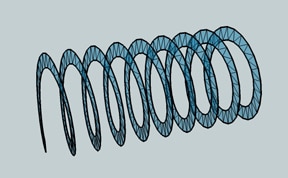
Propeller Spiral
Or another way to see it, is to observe the sweep of each blade as it passes through the water.

Propeller moving water through the water
Now if we tilt the shaft of the propeller down, the spiral also tilts down.
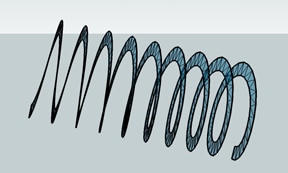
Tilted Propeller Shaft
But we have to put put a few prefaces on this. There must be no boat hull above to affect the initial flow of water, the water must be deep and the propeller can not be moving horizontally through the water – that’s a lot of prefaces and not reality. But here is what that would look like anyway.
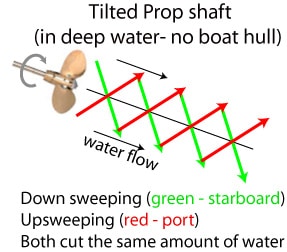
Propeller tilted down and moving forward
Now let’s put the propeller in close proximity to the hull of the boat where the water tends to move horizontally. This is represented here by the imaginary sweep lines. Here then you can see that the up-swinging reversing blade (green -starboard) cuts more of the flowing water similar to the tilting staircase example above.
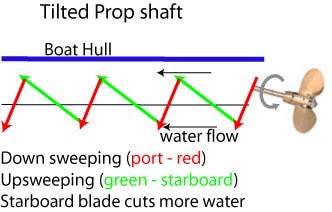
Propeller tilted with water moving horizontally
In much the same way as the tilting staircase, the down-sweeping blade cuts through less flowing water than the up-sweeping blade. This creates more force on the up-swinging side of the propeller than the down-swinging side and thus a torque is produced on the prop shaft.
This results in the following forces and thus a resultant clockwise torque on the boat.

Resultant torque on propeller
In a similar fashion, imagine yourself treading water in a swimming pool and your right arm swings in big circles while your left swings in smaller circles. Your body would move backward but the action would also turn your face to the right and consequently your back to the left. The boat turns in exactly the same way.
In forward gear, the exact same phenomenon occurs, just in the opposite direction. However, we notice it much less because the water from the propeller is being pushed over the rudder which creates far greater forces and thus counteracts any tilt-induced torque.
So in summary, a boat that has a counter-rotating shaft, when in reverse, yaws clockwise (stern to the left) because the shaft is tilting downwards. Factors to reduce the effect include having a smaller diameter propeller or reducing the pitch (twist) of the blade or lengthening the shaft so that the water flow is further from the boat which would tend to allow the water flow to be more in line with the shaft. The effect is also reduced by a slower turning propeller IE less engine RPM.
An alternative way of mounting the propeller is called a saildrive and these are widely accepted in Europe. Saildrive systems have a horizontally mounted propeller shaft and therefore they do not create prop walk.
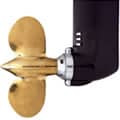
A sail drive unit does not experience prop walk
But there is no need to run out and go to the expense of converting your boat to a saildrive unit if you are experiencing frustration with prop walk. Because even with a sail drive the second phenomenon applies.
2. The Second Phenomenon is the Wash-Lift Effect
The wash-lift effect has been documented heavily by Dave Geer who is one of the worlds leading propeller engineers.
Dave wrote a white paper on the p-factor effect combined with this wash lift effect. We contacted Dave and asked him permission to make this white paper available to NauticEd students. He graciously accepted. For more in-depth reading on this, here is Dave Geer’s propwalk white paper for further interesting reading.
As the propeller turns and slices the water with its blades, it you imagine how it would push water out of the tilted blade, but not exactly directly horizontally. An upsweeping blade pushes water up as well as horizontally and a down-sweeping blade pushes water down as well as horizontally.
Similarly, the blade sweeping sideways at the top of the rotation pushes water sideways one way as well as aft. At the bottom sideways sweep of the propeller, the water is pushed in the opposite direction as well as aft. The horizontal component of the water movement creates thrust. The top and bottom sweeps sideways movements of the blades cancel each other out. The upsweep lifts water up under the hull and the down sweep sucks water down.
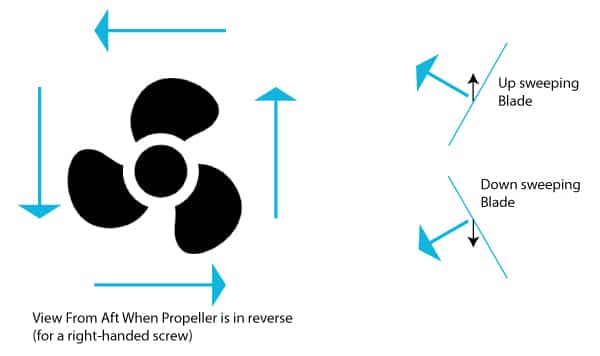
For a right-hand screw in reverse, water is pushed up creating a high-pressure wave on the starboard side of the hull. The water being pulled down on the port side of the hull creates a trough. The hull then slides sideways into the trough.
See the following animation, where you can see the wave forming which has an effect of a fire hose under the water pushing the hull sideways.
The wash-lift effect is present in boats with tilted shaft arrangements and sail drive arrangements. However, the propwalk effect is reduced when only operating with a saildrive. If you think about the tilted shaft effect, the upwash is greater because the blade is twisted more up on the upswing side.
The result is that tilted drive shaft boats have a much higher propwalk effect than sail drives. In many saildrive boats, you won’t notice the propwalk as much as in shaft drives.
Let’s Take a Look at Propwalk
In the NauticEd Virtual Reality Training program, you can experience a real sailboat and see how propwalk reveals itself. Here is a video that was recorded in the Virtual Reality program. We also show how you can beat propwalk in a certain common situation.
See the NauticEd Virtual Reality program here
Now You Understand
Now that you understand the theory of propwalk, all you have to do is practice the exercises in the NauticEd Maneuvering Under Power course a few times and you’ll have it licked.
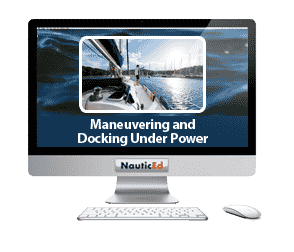
You can also get the NauticEd Maneuvering Under Power hybrid paper ebook from Amazon. The paper book has QR codes embedded throughout allowing the book to come alive when you scan the QR codes with any phone. Get the book tomorrow on Prime.
My vision for NauticEd is to provide the highest quality sailing and boating education available - and deliver competence wherever sailors live and go.
You might also like

TWEET ABOUT

FIGHT CHILDHOOD CANCER
NauticEd is a fully recognized education and certification platform for sailing students combining online and on-the-water real instruction ( and now VR ). NauticEd offers +24 online courses , a free sailor's toolkit that includes 2 free courses, and six ranks of certification – all integrated into NauticEd’s proprietary platform. The USCG and NASBLA recognize NauticEd as having met the established American National Standards. Learn more at www.nauticed.org .

The NauticEd Vacations team are Expert Global Yacht Charter Agents – when you book a sailing vacation or bareboat charter through NauticEd, we don’t charge you a fee – we often save you money since we can compare prices from all yacht charter companies. PLUS, we can give you advice on which destination or charter company will suit your needs best. Inquire about a Sailing Vacation or Charter .
Online Sailing Courses Sailing Vacations | Charters Practical Sailing Courses Sailing Certification | License
Sign up for 2 FREE Sailing Courses Try sailing in Virtual Reality! Gift a Friend a Sailing Course Sailing Events | Opportunities
About NauticEd Contact Us NauticEd Support Privacy Policy
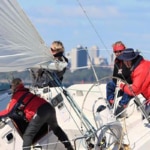

- Subscribe Now
- Digital Editions

Prop walk explained: What it is and how to use it to your advantage
- Top stories
Our resident boating instructor Jon Mendez explains the phenomenon of prop walk and how you can use it to your advantage.
When the propeller on a boat is turned by the engine, the majority of the force it produces pushes the boat ahead or astern. However, the shape of the blades also creates a small amount of sideways force which creates a turning effect on the boat as well.
This force has several names – prop walk, propeller effect, transverse thrust – they all mean the same thing but for clarity I will call it ‘prop walk’.
It’s most apparent and easiest to see on a shaft driven boat. You can visualise it by mentally replacing the propeller on your boat with a paddle wheel while viewing it from astern; when the propeller is turning clockwise, so to the right (called a right-handed propeller), it wants to paddle the stern of the boat over to starboard.
Article continues below…

How to berth a single-engined boat: Stern-to method explained

How to: Turn a single-engined boat in a tight space
When moving ahead this also causes the boat to pivot by turning the bow to port. When moving astern the effect is much more pronounced as the wash from the propeller is no longer going over the rudder so you can lose steering.
Now the turning effect of that same right-handed propeller in astern is to push the stern to port – and hence the bow to starboard. All of this happens the other way round with a left-handed propeller that spins anti-clockwise in ahead.
Knowing the rotation of your propeller is fundamental to all manoeuvres carried out on a single shaft boat, especially when going astern. Using this force to help with tight turns rather than hinder them is crucial as it gives you the ability to turn the craft ‘short’ – using the least amount of room.
To find out which way your boat’s propeller turns, while still securely tied to the berth briefly engage astern and see which side of the boat the wash comes out. If it exits to starboard it’s a right-handed propeller, if it exits to port then it’s a left-handed propeller.
Having worked out which way it turns and knowing that its effect is much greater in astern than ahead, it makes sense to always turn the boat using the prop walk effect in astern to push the stern the way it naturally wants to go and balance any fore and aft motion by using ahead and the power of water flowing over the rudder in short bursts to keep the turn going.
On a twin shaft boat, the starboard engine will usually have a right-hand propeller and the port engine a left-hand one. When both are used ahead or astern at the same time their prop effects cancel each other out but when used individually the prop walk of each engine can actually aid the manoeuvring process.
Our How To video series is brought to you in association with GJW Direct.
Witness appeal after reports of a motor boat collision
James bond’s birthday gift to the rnli, new boats at cannes boat show 2024: absolute navetta 53, latest videos, watch: parker sorrento sea trial: 50-knot cruiser with a killer aft cabin, watch: virtue v10 sea trial: €272k weekender, how to mark your anchor chain: 6 top tips from our expert, watch: galeon 560 fly sea trial – the best galeon flybridge you can buy.

IMAGES